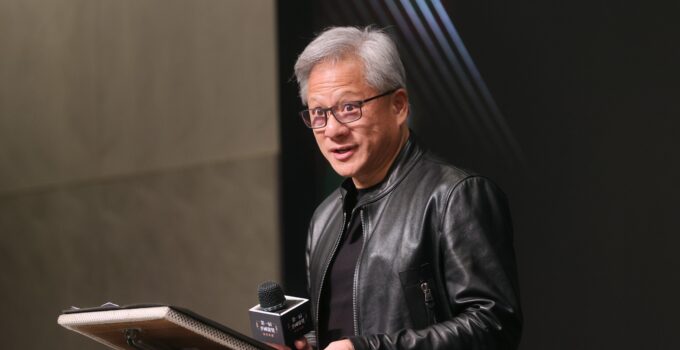When most people think of the future, they picture AI engineers, coders, and Silicon Valley tech bros. But Nvidia CEO Jensen Huang is betting big on something different.
According to Huang, the next great wave of opportunity won’t be in white-collar office jobs — it’ll be in the trades. Electricians. Plumbers. Carpenters. The kinds of jobs your high school probably didn’t hype up — but should have.
And Huang isn’t just making a philosophical point. His company is helping pump billions into building the infrastructure of the AI economy — and it’s skilled tradespeople, not college grads, who’ll be laying the literal foundation.
“We’ll Need Hundreds of Thousands of Them”
Speaking to Channel 4 News, Huang put it simply: “If you’re an electrician, you’re a plumber, a carpenter — we’re going to need hundreds of thousands of them to build all of these factories.”
He’s referring to the coming explosion of AI data centers — enormous facilities designed to handle the ever-growing demand for artificial intelligence processing. These aren’t sci-fi pipe dreams. They’re already happening.
And it’s not just a blip. “The skilled craft segment of every economy is going to see a boom,” Huang added. “You’re going to have to be doubling and doubling and doubling every single year.”
This isn’t theory. It’s a forecast backed by hard cash.
Nvidia’s $100 Billion Bet on the Trades
Huang’s company, Nvidia, recently committed a staggering $100 billion investment into OpenAI to help power new data centers — the physical backbone of the AI boom. These centers rely on Nvidia’s ultra-powerful processors, but without electricians and builders, the chips mean nothing.
McKinsey estimates global capital spending on data centers will hit $7 trillion by 2030. That’s a wave few industries can match — and it’s only getting started.
To put it in perspective: a single 250,000-square-foot data center can employ up to 1,500 construction workers during its build. These aren’t minimum-wage jobs either. Many of these workers earn over $100,000 a year, plus overtime — no college degree required.
Once built, each facility still employs around 50 full-time roles, from facilities engineers to maintenance techs. But more importantly, each job supports 3.5 more in the surrounding economy — from local food services to logistics.
A Career Path That Pays — Without Student Debt
Jensen Huang isn’t just selling the dream. He’s a walking example of it. Before becoming a billionaire CEO, he worked as a dishwasher at Denny’s. His path wasn’t traditional. It was practical.
And he believes young people need to start thinking practically too.
When asked what he’d study if he were 20 again, Huang said he’d pursue the physical sciences — not software. It’s a sharp shift from the advice most Gen Zers have heard for years: “Learn to code or get left behind.”
Huang is flipping the script.
“Act Now — Or We’ll Run Out of Workers”
Jensen Huang isn’t the only CEO sounding the alarm.
BlackRock’s Larry Fink has also warned about a skilled labor shortage — pointing directly at AI data center construction. According to Fink, there’s a growing disconnect between policy and people.
“I’ve even told members of the Trump team that we’re going to run out of electricians that we need to build out AI data centers,” Fink said earlier this year. “We just don’t have enough.”
Jim Farley, CEO of Ford, made a similar point this week. As the U.S. pushes to reshore manufacturing and tech, Farley says there’s one massive problem: we don’t have enough people to do the work.
Currently, the U.S. is short:
-
600,000 factory workers
-
500,000 construction workers
And that number is climbing.
Gen Z Is Already Starting to Pivot
Not every young person is buying the four-year-degree dream.
Jacob Palmer, a 23-year-old from North Carolina, skipped college. Instead, he joined a contracting apprenticeship and trained as an electrician.
By age 21, he launched his own business. Last year, he pulled in nearly $90,000. This year? He’s already hit six figures — while his peers are swimming in student debt and struggling to land entry-level jobs.
“I don’t owe anybody anything,” Palmer said.
He’s not the exception. He’s the start of a shift.
Trade School > Job Board
Right now, America has a paradox: tons of job openings, but not enough skilled people to fill them. That’s why the Department of Education has prioritized skilled trades expansion in its long-term plans.
But here’s the catch: awareness still lags behind. Schools still push college as the “safe” option. Meanwhile, tech leaders are screaming for carpenters, pipefitters, welders, HVAC techs, and cable installers.
These jobs don’t just pay well — they can’t be outsourced, and they’re incredibly resilient in an AI-driven world.
What This Means for Entrepreneurs
If you’re building a business — especially in ecommerce, SaaS, or digital services — this boom still affects you.
Why?
Because the physical infrastructure of the internet is what powers your company. Data centers = the cloud. Fiber optics = your Zoom calls. Cooling systems = your website uptime.
The next time you see a construction worker, you’re probably looking at someone building the literal foundation of your business.
And if you’re recruiting talent, expect to see rising wages and demand for people with hands-on skills. Smart companies will start partnering with trade schools, launching paid apprenticeships, or even investing in upskilling programs for their own staff.
The Future Is Built, Not Just Coded
There’s no denying that AI is the future. But it doesn’t just live in code. It lives in cables. Racks. HVAC systems. Steel. Bricks. Cement.
Jensen Huang knows it. Larry Fink knows it. Jim Farley knows it.
And the people who’ll thrive over the next 10 years won’t just be the ones writing algorithms. They’ll be the ones building the machines that make it all possible.

Jordan Ellis is a business writer and digital strategist at Hustle Framework, focused on practical tools and actionable insights for entrepreneurs. Passionate about helping you make smarter business decisions.




